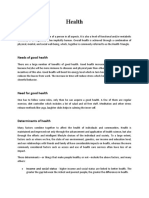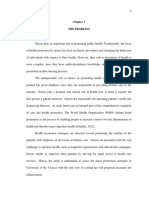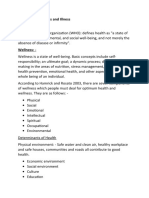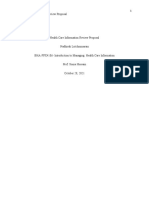0 ratings0% found this document useful (0 votes)
68 viewsHealth Education Reviewer
Health Education Reviewer
Uploaded by
Marylene Conge AbantaoHealth promotion is a key component of nursing practice that focuses on socioeconomic and environmental determinants of health. It includes health education, identification of health risks, empowerment, advocacy, preventive healthcare, and policy development. Nurses promote health by considering how organizational, environmental, economic, sociocultural, and behavioral factors influence a patient's health. Health is defined broadly by WHO as complete physical, mental, social and emotional well-being, rather than just the absence of disease. Primary, secondary and tertiary prevention focus on protecting individuals from disease and increasing well-being at different stages.
Copyright:
© All Rights Reserved
Available Formats
Download as PDF, TXT or read online from Scribd
Health Education Reviewer
Health Education Reviewer
Uploaded by
Marylene Conge Abantao0 ratings0% found this document useful (0 votes)
68 views3 pagesHealth promotion is a key component of nursing practice that focuses on socioeconomic and environmental determinants of health. It includes health education, identification of health risks, empowerment, advocacy, preventive healthcare, and policy development. Nurses promote health by considering how organizational, environmental, economic, sociocultural, and behavioral factors influence a patient's health. Health is defined broadly by WHO as complete physical, mental, social and emotional well-being, rather than just the absence of disease. Primary, secondary and tertiary prevention focus on protecting individuals from disease and increasing well-being at different stages.
Original Description:
hihi
Copyright
© © All Rights Reserved
Available Formats
PDF, TXT or read online from Scribd
Share this document
Did you find this document useful?
Is this content inappropriate?
Health promotion is a key component of nursing practice that focuses on socioeconomic and environmental determinants of health. It includes health education, identification of health risks, empowerment, advocacy, preventive healthcare, and policy development. Nurses promote health by considering how organizational, environmental, economic, sociocultural, and behavioral factors influence a patient's health. Health is defined broadly by WHO as complete physical, mental, social and emotional well-being, rather than just the absence of disease. Primary, secondary and tertiary prevention focus on protecting individuals from disease and increasing well-being at different stages.
Copyright:
© All Rights Reserved
Available Formats
Download as PDF, TXT or read online from Scribd
Download as pdf or txt
0 ratings0% found this document useful (0 votes)
68 views3 pagesHealth Education Reviewer
Health Education Reviewer
Uploaded by
Marylene Conge AbantaoHealth promotion is a key component of nursing practice that focuses on socioeconomic and environmental determinants of health. It includes health education, identification of health risks, empowerment, advocacy, preventive healthcare, and policy development. Nurses promote health by considering how organizational, environmental, economic, sociocultural, and behavioral factors influence a patient's health. Health is defined broadly by WHO as complete physical, mental, social and emotional well-being, rather than just the absence of disease. Primary, secondary and tertiary prevention focus on protecting individuals from disease and increasing well-being at different stages.
Copyright:
© All Rights Reserved
Available Formats
Download as PDF, TXT or read online from Scribd
Download as pdf or txt
You are on page 1of 3
Health Education Reviewer
“Health Education, Health Promotion and Health: What do these definitions have to do with
nursing?”
Health Promotion is a key component of nursing practice.
By promoting the health of individuals, family and community, the nurses help transform the
health of individuals, our society and our healthcare system.
Florence Nightingale - influenced modern definition of nursing by focusing on triad of person,
health and environment while stressing the promotion of health and healing.
American Nurses’ Association (ANA) - defined nursing as the protection, promotion, and
optimization of health and abilities, prevention of injury and illness, alleviation of suffering
through diagnosis and human response and advocacy in the care of families, individuals,
communities and populations.
International Council of Nursing -defined nursing as” including promotion of health, prevention
of illness, and the acre of ill, disabled and dying people.
Health Education VS Health Promotion
Health Education and Health Promotion are distinct activities.
Health Promotion focuses on socioeconomic and environmental determinants of health while
Health Education involves giving information and teaching individuals and communities how to
achieve better health.
Definition of Health Promotion
Health Promotion includes health education, identification, reduction of health risk for selected
individuals and population, empowerment, advocacy, preventive health care, and health policy
development.
Health Promotion includes health education and motivating lifestyle and change of behavior
based on careful understanding of the patient’s situation, economic resources, educational
background, social supports, cultural beliefs and environmental factors in the community.
Health is influenced by feeling such as pain levels, energy levels, and the ability to perform ones
job or social role.
Medical Model and World Health Organization Definitions of Health (WHO)
Health in medical model is defined as an absence of physical and mental disease.
Health is also defined broadly by the WHO as “the complete state of physical, mental, social
and emotional well-being not merely the absence of disease.”
Meaning and Purpose as part of Health
The concept of health also include the sense of meaning and purpose or knowledge that one’s
life make difference.
Nurses need to explore what brings a sense of meaning to the patients and communities they
work with to effectively design intervention that will be satisfying.
Perception is a vital aspect of health that nurses must consider.
Many authors have argued that illness can be a catalyst for health and growth. Illness often
prompts individual to reflect on their life, to consider what is important to them.
FACTORS AFFECTING HEALTH
Organizational Factor Affecting Health
Considering which Organizational factors influence health is important aspect of what nurses do
when promoting the health of their patient.
Environmental Factor Affecting Health
It is necessary for nurses to consider environmental factor before working the client.
Examples:
Exposure to hazardous substances in the air, water, soil, and food
Natural and technological disasters
Climate change
Occupational hazards
The built environment
Economic Factor Affecting Health
For example, sometimes elderly patient with limited incomes have decide which of their
medications will be refilled. Or take only half of the medications prescribed by their physician
because they cant afford to fill the whole prescription
Sociocultural Factor Affecting Health
Sociocultural factors can have major impact on health belief, health practice and health
communication and also the trust to health practitioner.
Examples:
Education
Income
Exposure to Violence
Access to healthcare
Behavioral Factors Affecting Health
A variety of behavioral factors influence whether the patient will comply to the treatment.
Sometimes lack of compliance and adherence with ordered care is based on previous negative
experiences with the healthcare system.
The Relationship Between Health Promotion, Health and Illness Prevention
Defining health as well-being laid the foundation of health promotion practice and expanded the
role of nursing and medicine beyond just disease and treatment.
Wellness
Dunn, the father of the wellness movement, advocated the maximizing of human potential by
simultaneously focusing on mind, body and spirit.
He stressed the importance of personality, motivation, environment, and capacity to change.
Primary, Secondary, and Tertiary Prevention
Primary prevention and health promotion both focus on protecting individuals and communities
from disease and increasing health and well- being
Secondary prevention aims to halt disease progression before it become more acute and is
designed to lessen complications and disability.
Tertiary prevention is often called rehabilitation. It begins once a disease has stabilized and
aims to restore the individual to their highest level of functioning.
References: Bonnie Raingruber, Jones & Bartlett Learning
You might also like
- Letter 2024 01 18 1Document4 pagesLetter 2024 01 18 1jennifermoule0No ratings yet
- CHN Lecture 1Document20 pagesCHN Lecture 1knotstm100% (1)
- Scenario 4Document3 pagesScenario 4api-655123959No ratings yet
- Importance of The Nursing Process and The Importance of Health EducationDocument51 pagesImportance of The Nursing Process and The Importance of Health EducationMary Jane TiangsonNo ratings yet
- Potter: Basic Nursing, 7th Edition: Chapter 1: Health and Wellness Key Points - PrintDocument1 pagePotter: Basic Nursing, 7th Edition: Chapter 1: Health and Wellness Key Points - PrintDonald KarpNo ratings yet
- Lecture 2 Public Health Nutrition - Health Promotion and Theories of Behaviour Change-1Document98 pagesLecture 2 Public Health Nutrition - Health Promotion and Theories of Behaviour Change-1Eric MensahNo ratings yet
- Health: Needs of Good HealthDocument6 pagesHealth: Needs of Good HealthRahul GuptaNo ratings yet
- Research ArticleDocument32 pagesResearch ArticleEliezer NuenayNo ratings yet
- Khamlin Hamad Abdal - Groupa''Document23 pagesKhamlin Hamad Abdal - Groupa''Khamlin NurseNo ratings yet
- Health Psychology: Bio Psychosocial Perspective: Ranya Al-Mandawi Dr. Tyrin Stevenson Psych 331Document6 pagesHealth Psychology: Bio Psychosocial Perspective: Ranya Al-Mandawi Dr. Tyrin Stevenson Psych 331Ranya NajiNo ratings yet
- Promotion in Nursing Practice (1982) - She Developed The Idea That Promoting Optimal Health SupersedesDocument8 pagesPromotion in Nursing Practice (1982) - She Developed The Idea That Promoting Optimal Health SupersedeskramprincessNo ratings yet
- Concept of Wellness and IllnessDocument6 pagesConcept of Wellness and IllnessGomathi SharmaNo ratings yet
- Primary Health CareDocument13 pagesPrimary Health CareHUSSAINA BANONo ratings yet
- Unit - 1Document35 pagesUnit - 1Pela KqbcgrlaNo ratings yet
- Introduction To CPH and History of Public Health IDocument6 pagesIntroduction To CPH and History of Public Health IReynajane TugadiNo ratings yet
- Pender's TheoryDocument8 pagesPender's Theorycarendleon93% (15)
- What Is Health PromotionDocument23 pagesWhat Is Health PromotionPrimalj Pinnaduwa100% (1)
- Community Health NursingDocument105 pagesCommunity Health NursingKBDNo ratings yet
- Reflection On Nursing FundamentalsDocument7 pagesReflection On Nursing FundamentalsFred Ashira AuraNo ratings yet
- CHN Week 1 Sy 2022Document54 pagesCHN Week 1 Sy 2022Moon KillerNo ratings yet
- CHN NOTES Community 2Document16 pagesCHN NOTES Community 2kathleya100% (1)
- ASP Unit 2 HealthDocument23 pagesASP Unit 2 HealthKalloljyoti OjahNo ratings yet
- Nola Pender Health Promotion ModelDocument7 pagesNola Pender Health Promotion ModelIresef LariosaNo ratings yet
- Introduction To Public Health (1 & 2)Document67 pagesIntroduction To Public Health (1 & 2)Abdulahi Bedel100% (1)
- Health-Illness ContinuumDocument5 pagesHealth-Illness ContinuumSamwel KangyNo ratings yet
- Health Education and Contagious Diseases Group 1Document32 pagesHealth Education and Contagious Diseases Group 1Jason CamaNo ratings yet
- Module One: Concepts, Principles and Appreoaches of Public HealthDocument9 pagesModule One: Concepts, Principles and Appreoaches of Public HealthFelix KimothoNo ratings yet
- InitialDocument10 pagesInitialAhmedNo ratings yet
- Health PromotionDocument16 pagesHealth PromotionSushma LathNo ratings yet
- Community Medicine - Introduction To Public Health & DimensionDocument30 pagesCommunity Medicine - Introduction To Public Health & Dimensionbashar0901052795No ratings yet
- Essay GalanDocument1 pageEssay GalanDaniel Angelo ArangoNo ratings yet
- 1 Health Promotion An OverviewDocument7 pages1 Health Promotion An OverviewFatima SajedNo ratings yet
- Health ModelsDocument3 pagesHealth ModelsRichard RawatNo ratings yet
- Health Care PracticeDocument9 pagesHealth Care Practiceheer20299No ratings yet
- Medical Definition of BiomedicalDocument4 pagesMedical Definition of BiomedicalRishel Mae Besinga PantallanoNo ratings yet
- Why is being healthy a Responsibility_Gp presentation(Final)Document12 pagesWhy is being healthy a Responsibility_Gp presentation(Final)aditya.suraj.agrawalNo ratings yet
- Running Head: LITERATURE REVIEW 1Document7 pagesRunning Head: LITERATURE REVIEW 1Seymour WardNo ratings yet
- Health PromotionDocument30 pagesHealth PromotionWiradianto PutroNo ratings yet
- Health Psychology CHP 15Document15 pagesHealth Psychology CHP 15Arooba JavedNo ratings yet
- RevisedDocument9 pagesRevisedAhmedNo ratings yet
- Health Education Topic1Document4 pagesHealth Education Topic1Capuli, Rian Josh G.No ratings yet
- Assignment 2Document15 pagesAssignment 2NOOR HALIZA BINTI ALI (HMELAKA)No ratings yet
- chn reviewsDocument10 pageschn reviewsallyssabatuhan08No ratings yet
- 1-Health Education - Intro, Aims & ScopeDocument18 pages1-Health Education - Intro, Aims & ScopeSajida Bibi NoonariNo ratings yet
- Health Promotion Lecture Notes 2023 (Autosaved)Document44 pagesHealth Promotion Lecture Notes 2023 (Autosaved)perssivesimangavwa2002No ratings yet
- Concepts in Public Health and Preventive MedicineDocument16 pagesConcepts in Public Health and Preventive MedicineMohammed AlwardiNo ratings yet
- Evolução Dso Modelos de Assistência MédicaDocument9 pagesEvolução Dso Modelos de Assistência MédicaDaniel SousaNo ratings yet
- Health: Draishasultana PT, DPT Lecturer Institute of Physiotherapy and Rehabilitation Sciences LumhsjamshoroDocument12 pagesHealth: Draishasultana PT, DPT Lecturer Institute of Physiotherapy and Rehabilitation Sciences LumhsjamshoroSajida Bibi NoonariNo ratings yet
- Human Health, Public Health and Health's Promotion. ConsiderationsDocument44 pagesHuman Health, Public Health and Health's Promotion. ConsiderationsAbhishek dubeyNo ratings yet
- Self Health ConceptDocument18 pagesSelf Health Conceptgrace youthamNo ratings yet
- MPU3313 MPU2313 Topic 6Document26 pagesMPU3313 MPU2313 Topic 6CheAzahariCheAhmad100% (1)
- CHN Concepts CompiledDocument81 pagesCHN Concepts CompiledTenIs ForMe0% (1)
- Introduction To Health and WellnesDocument62 pagesIntroduction To Health and WellnesZgama Abdulrahman100% (1)
- Health EducationDocument11 pagesHealth EducationHaleema SaadiaNo ratings yet
- Nursing Health AssessmentDocument51 pagesNursing Health Assessmentjohnbrkti1002No ratings yet
- Health IllnessDocument5 pagesHealth IllnessVINCENT MUHARINo ratings yet
- Name: Krizza Marie A. Antonio Bsn-1 Set 2Document2 pagesName: Krizza Marie A. Antonio Bsn-1 Set 2Gelo SuacilloNo ratings yet
- Health and Its DeterminantsDocument7 pagesHealth and Its Determinantshardio damselgold.No ratings yet
- The History of Community NursingDocument13 pagesThe History of Community NursingScribdTranslationsNo ratings yet
- Principles of Health Promotion: DR Celine MurrinDocument40 pagesPrinciples of Health Promotion: DR Celine MurrinKatie NolanNo ratings yet
- Lecture-1: University of Kufa Faculty of Nursing, Community Health Nursing BranchDocument27 pagesLecture-1: University of Kufa Faculty of Nursing, Community Health Nursing Branchآمنة محمد كاظمNo ratings yet
- 4050 A1 - Preliminary Care Coordination PlanDocument6 pages4050 A1 - Preliminary Care Coordination PlangeorgehanningtoneNo ratings yet
- Medical Fitness Certificate FORMATDocument2 pagesMedical Fitness Certificate FORMATpriyanshuNo ratings yet
- Integrated Shield Plans For Ward Class B2/C in Public Hospitals pg1Document4 pagesIntegrated Shield Plans For Ward Class B2/C in Public Hospitals pg1pervinder singhNo ratings yet
- Mohammed ResumeDocument2 pagesMohammed Resumerokamagdy23No ratings yet
- ApprovedList 2020 21Document4 pagesApprovedList 2020 21Harish RamachandranNo ratings yet
- LMMU SOMCS 2023 FeesDocument1 pageLMMU SOMCS 2023 FeesMatthias Junior KamangaNo ratings yet
- Aprn InterviewDocument4 pagesAprn Interviewapi-620258967No ratings yet
- Letter Gov HiyastagalogDocument1 pageLetter Gov HiyastagalogAte GandaNo ratings yet
- Revised - Telephonic Intake Script3Document2 pagesRevised - Telephonic Intake Script3Chris RiveraNo ratings yet
- Group Medical Insurance Claim Form Section 2Document1 pageGroup Medical Insurance Claim Form Section 2Aditya SharmaNo ratings yet
- Gp 69 Medical Form (1)Document2 pagesGp 69 Medical Form (1)rocky princeNo ratings yet
- Data Anggota-9-1Document25 pagesData Anggota-9-1Maratus SholikahNo ratings yet
- Grover 2020Document2 pagesGrover 2020Riza Agung NugrahaNo ratings yet
- BHA-FPX4106 - Nadhirah Lutchminarain - Assignment 3Document19 pagesBHA-FPX4106 - Nadhirah Lutchminarain - Assignment 3Nadhirah De WetNo ratings yet
- Hugo Hennessy - American Dream Essay FinalDocument9 pagesHugo Hennessy - American Dream Essay Finalapi-692563078No ratings yet
- Clinical Rotation Plan NoteDocument3 pagesClinical Rotation Plan NoteVaidehi SahuNo ratings yet
- BTPL PPT (Factories Act)Document15 pagesBTPL PPT (Factories Act)sameera.sales24No ratings yet
- University of Negros Occidental - Recoletos College of Allied Medical Health SciencesDocument6 pagesUniversity of Negros Occidental - Recoletos College of Allied Medical Health SciencesNecy Tessa C. AcostaNo ratings yet
- Public Health AdministrationDocument4 pagesPublic Health AdministrationAmirAmeer AliNo ratings yet
- Medication Error Concept and Reporting Practices in Saudi Arabia A Multiregional Study Among Healthcare ProfessionalsDocument13 pagesMedication Error Concept and Reporting Practices in Saudi Arabia A Multiregional Study Among Healthcare ProfessionalsAbdulRahman MuthannaNo ratings yet
- Ayushman Bharat ProgrammeDocument14 pagesAyushman Bharat Programmesri sathya sai prashanth nalluriNo ratings yet
- 2025 Uhc Medicare Basics AssessmentDocument4 pages2025 Uhc Medicare Basics Assessmentsalvy3292No ratings yet
- Akash Medical CollegeDocument22 pagesAkash Medical CollegeShakthi VelNo ratings yet
- Service Standard 09C Clinical Services Obstetrics - Gynaecology ServicesDocument31 pagesService Standard 09C Clinical Services Obstetrics - Gynaecology ServicesSuhaimeNo ratings yet
- Delta Dental Plan Compare Highlight SheetDocument2 pagesDelta Dental Plan Compare Highlight SheetTiffany BarnesNo ratings yet
- Encyclopedia of Health Services ResearchDocument1,441 pagesEncyclopedia of Health Services ResearchJerry KanneNo ratings yet
- Chandigarh DoctorsDocument13 pagesChandigarh DoctorsDhruv VasudevaNo ratings yet
- JD - Radiographer MRI-CT - Sulis Feb 2024Document4 pagesJD - Radiographer MRI-CT - Sulis Feb 2024mrxmdxsc7nNo ratings yet

























































































